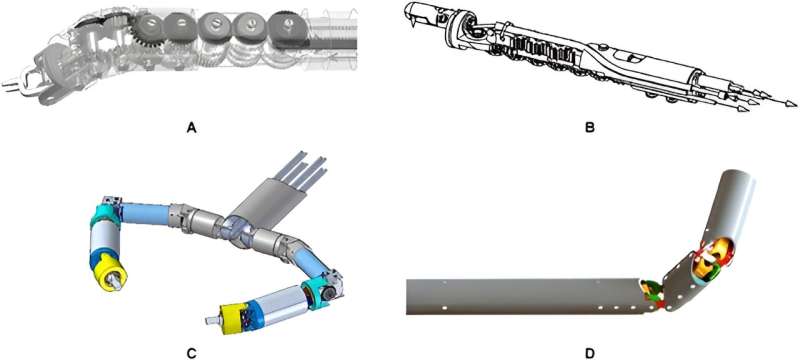This article has been reviewed according to Science X's editorial process and policies. Editors have highlighted the following attributes while ensuring the content's credibility:
fact-checked
peer-reviewed publication
proofread
A survey of transoral robotic mechanisms: Distal dexterity, variable stiffness, and triangulation

A review paper by scientists at The Chinese University of Hong Kong summarized the mechanisms related to distal dexterity, variable stiffness (VS), and triangulation in developing transoral robotic surgery (TORS).
This review paper, published in the journal Cyborg and Bionic Systems, provided an overview of the distal dexterity mechanisms, variable stiffness mechanisms, and triangulation mechanisms, which are closely related to the specific technical challenges of TORS.
"TORS has completely revolutionized the diagnosis and treatment of diseases in the upper aerodigestive tract, the advantages of which include: the more efficient and precise surgical operations, the faster postoperative recovery as well as increased functional outcomes," explained the author Hongliang Ren, a professor at The Chinese University of Hong Kong. Robot-assisted technologies are being investigated to overcome the limitations of the current solutions for transoral surgeries, which suffer from constrained insertion ports, lengthy and indirect passageways, and narrow anatomical structures.
"Although they have achieved some encouraging outcomes and been approved for marketing, they cannot address most of the specific technical challenges presented by TORS," said the study authors. The merits and demerits of these designs are discussed to provide a reference for developing new SRSs capable of overcoming the limitations of existing systems and addressing challenges imposed by TORS procedure.
"According to the structure features in moving and orienting end effectors, the distal dexterity designs can be classified into 4 categories: serial mechanism, continuum mechanism, parallel mechanism, and hybrid mechanism. To ensure adequate adaptability, conformability, and safety, surgical robots must have high flexibility, which can be achieved by varying the stiffness. VS mechanisms based on their working principles in TORS include phase-transition-based VS mechanism, jamming-based VS mechanism, and structure-based VS mechanism. Triangulations aim to obtain enough workspace and create adequate traction and counter traction for various operations, including visualization, retraction, dissection, and suturing, with independently controllable manipulators," said Gu.
The study authors discussed mechanisms related to distal dexterity, VS, and triangulation in developing SRSs—for example, distal dexterity as the core research mechanism of the surgical robot. Meanwhile, they also discussed the TORS background, significance, and technical challenges.
Looking forward, new robotic technologies shall address challenges imposed by the TORS and develop surgical robots with improved performance to overcome the limitations of current designs and explore the full potential of TORS. New mechanisms, particularly flexible PMs that can adopt the flexible deformation of super elastic materials instead of rigid links and complex components as adopted in the traditional parallel mechanism, are promising to generate flexible and dexterous motions aiming at addressing challenges presented by TORS in terms of the size, workspace, flexibility, dexterity, load capacity, and safety.
"New SRS developments shall resolve the contradiction between flexibility, motion accuracy, and load capacity. Future SRS contains manipulators with VS that can possess sufficient compliance to ensure adequate safety while keeping an acceptable stiffness level for manipulation with adequate precision in the confined surgical site, which can be used in managing cancers in the oropharynx," said Gu.
The review paper calls for researchers, medical professionals, and other experts to collaboratively marshal the research on TORS mechanisms for providing references for future robot designs.
More information: Xiaoyi Gu et al, A Survey of Transoral Robotic Mechanisms: Distal Dexterity, Variable Stiffness, and Triangulation, Cyborg and Bionic Systems (2023). DOI: 10.34133/cbsystems.0007

















